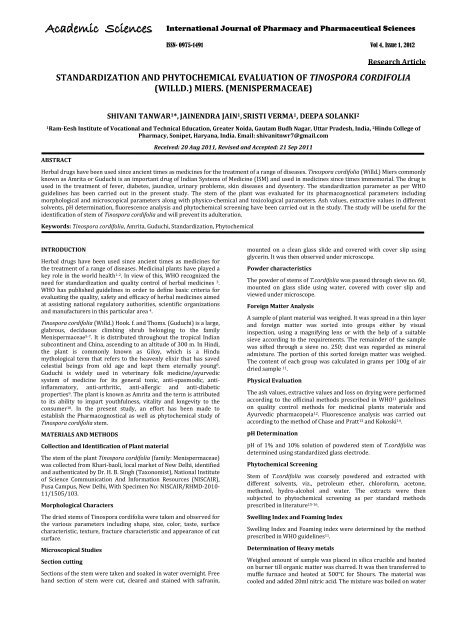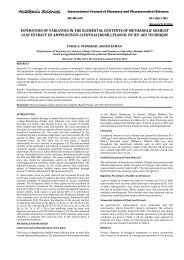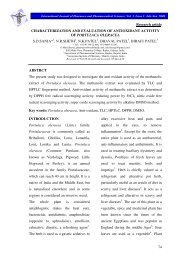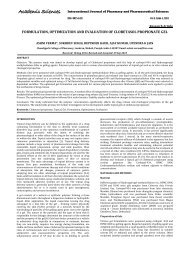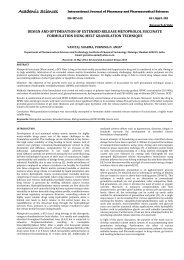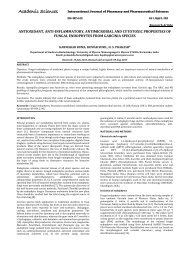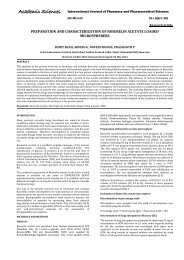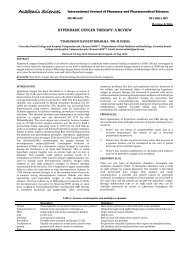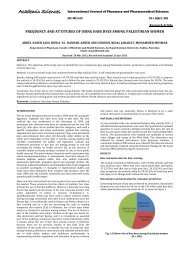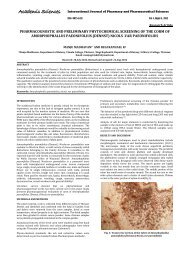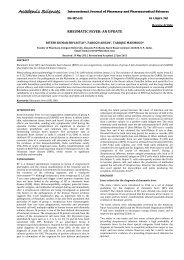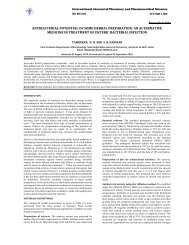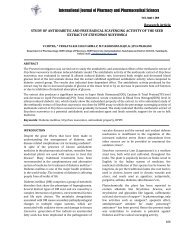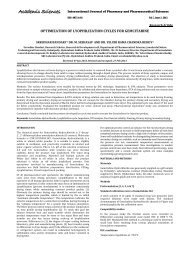standardization and phytochemical evaluation of tinospora cordifolia
standardization and phytochemical evaluation of tinospora cordifolia
standardization and phytochemical evaluation of tinospora cordifolia
Create successful ePaper yourself
Turn your PDF publications into a flip-book with our unique Google optimized e-Paper software.
Academic Sciences<br />
Research Article<br />
STANDARDIZATION AND PHYTOCHEMICAL EVALUATION OF TINOSPORA CORDIFOLIA<br />
(WILLD.) MIERS. (MENISPERMACEAE)<br />
SHIVANI TANWAR 1 *, JAINENDRA JAIN 1 , SRISTI VERMA 1 , DEEPA SOLANKI 2<br />
1 Ram-Eesh Institute <strong>of</strong> Vocational <strong>and</strong> Technical Education, Greater Noida, Gautam Budh Nagar, Uttar Pradesh, India, 2 Hindu College <strong>of</strong><br />
Pharmacy, Sonipet, Haryana, India. Email: shivanitnwr7@gmail.com<br />
ABSTRACT<br />
Received: 20 Aug 2011, Revised <strong>and</strong> Accepted: 21 Sep 2011<br />
Herbal drugs have been used since ancient times as medicines for the treatment <strong>of</strong> a range <strong>of</strong> diseases. Tinospora <strong>cordifolia</strong> (Willd.) Miers commonly<br />
known as Amrita or Guduchi is an important drug <strong>of</strong> Indian Systems <strong>of</strong> Medicine (ISM) <strong>and</strong> used in medicines since times immemorial. The drug is<br />
used in the treatment <strong>of</strong> fever, diabetes, jaundice, urinary problems, skin diseases <strong>and</strong> dysentery. The <strong>st<strong>and</strong>ardization</strong> parameter as per WHO<br />
guidelines has been carried out in the present study. The stem <strong>of</strong> the plant was evaluated for its pharmacognostical parameters including<br />
morphological <strong>and</strong> microscopical parameters along with physico-chemical <strong>and</strong> toxicological parameters. Ash values, extractive values in different<br />
solvents, pH determination, fluorescence analysis <strong>and</strong> <strong>phytochemical</strong> screening have been carried out in the study. The study will be useful for the<br />
identification <strong>of</strong> stem <strong>of</strong> Tinospora <strong>cordifolia</strong> <strong>and</strong> will prevent its adulteration.<br />
Keywords: Tinospora <strong>cordifolia</strong>, Amrita, Guduchi, St<strong>and</strong>ardization, Phytochemical<br />
INTRODUCTION<br />
Herbal drugs have been used since ancient times as medicines for<br />
the treatment <strong>of</strong> a range <strong>of</strong> diseases. Medicinal plants have played a<br />
key role in the world health1-2 . In view <strong>of</strong> this, WHO recognized the<br />
need for <strong>st<strong>and</strong>ardization</strong> <strong>and</strong> quality control <strong>of</strong> herbal medicines 3 .<br />
WHO has published guidelines in order to define basic criteria for<br />
evaluating the quality, safety <strong>and</strong> efficacy <strong>of</strong> herbal medicines aimed<br />
at assisting national regulatory authorities, scientific organizations<br />
<strong>and</strong> manufacturers in this particular area 4 .<br />
Tinospora <strong>cordifolia</strong> (Willd.) Hook. f. <strong>and</strong> Thoms. (Guduchi) is a large,<br />
glabrous, deciduous climbing shrub belonging to the family<br />
Menispermaceae 5-7 . It is distributed throughout the tropical Indian<br />
subcontinent <strong>and</strong> China, ascending to an altitude <strong>of</strong> 300 m. In Hindi,<br />
the plant is commonly known as Giloy, which is a Hindu<br />
mythological term that refers to the heavenly elixir that has saved<br />
celestial beings from old age <strong>and</strong> kept them eternally young 8 .<br />
Guduchi is widely used in veterinary folk medicine/ayurvedic<br />
system <strong>of</strong> medicine for its general tonic, anti-spasmodic, antiinflammatory,<br />
anti-arthritic, anti-allergic <strong>and</strong> anti-diabetic<br />
properties 9 . The plant is known as Amrita <strong>and</strong> the term is attributed<br />
to its ability to impart youthfulness, vitality <strong>and</strong> longevity to the<br />
consumer 10 . In the present study, an effort has been made to<br />
establish the Pharmacognostical as well as <strong>phytochemical</strong> study <strong>of</strong><br />
Tinospora <strong>cordifolia</strong> stem.<br />
MATERIALS AND METHODS<br />
Collection <strong>and</strong> Identification <strong>of</strong> Plant material<br />
The stem <strong>of</strong> the plant Tinospora <strong>cordifolia</strong> (family: Menispermaceae)<br />
was collected from Khari-baoli, local market <strong>of</strong> New Delhi, identified<br />
<strong>and</strong> authenticated by Dr. H. B. Singh (Taxonomist), National Institute<br />
<strong>of</strong> Science Communication And Information Resources (NISCAIR),<br />
Pusa Campus, New Delhi, With Specimen No: NISCAIR/RHMD-2010-<br />
11/1505/103.<br />
Morphological Characters<br />
The dried stems <strong>of</strong> Tinospora <strong>cordifolia</strong> were taken <strong>and</strong> observed for<br />
the various parameters including shape, size, color, taste, surface<br />
characteristic, texture, fracture characteristic <strong>and</strong> appearance <strong>of</strong> cut<br />
surface.<br />
Microscopical Studies<br />
Section cutting<br />
Sections <strong>of</strong> the stem were taken <strong>and</strong> soaked in water overnight. Free<br />
h<strong>and</strong> section <strong>of</strong> stem were cut, cleared <strong>and</strong> stained with safranin,<br />
International Journal <strong>of</strong> Pharmacy <strong>and</strong> Pharmaceutical Sciences<br />
ISSN- 0975-1491 Vol 4, Issue 1, 2012<br />
mounted on a clean glass slide <strong>and</strong> covered with cover slip using<br />
glycerin. It was then observed under microscope.<br />
Powder characteristics<br />
The powder <strong>of</strong> stems <strong>of</strong> T.<strong>cordifolia</strong> was passed through sieve no. 60,<br />
mounted on glass slide using water, covered with cover slip <strong>and</strong><br />
viewed under microscope.<br />
Foreign Matter Analysis<br />
A sample <strong>of</strong> plant material was weighed. It was spread in a thin layer<br />
<strong>and</strong> foreign matter was sorted into groups either by visual<br />
inspection, using a magnifying lens or with the help <strong>of</strong> a suitable<br />
sieve according to the requirements. The remainder <strong>of</strong> the sample<br />
was sifted through a sieve no. 250; dust was regarded as mineral<br />
admixture. The portion <strong>of</strong> this sorted foreign matter was weighed.<br />
The content <strong>of</strong> each group was calculated in grams per 100g <strong>of</strong> air<br />
dried sample 11 .<br />
Physical Evaluation<br />
The ash values, extractive values <strong>and</strong> loss on drying were performed<br />
according to the <strong>of</strong>ficinal methods prescribed in WHO 11 guidelines<br />
on quality control methods for medicinal plants materials <strong>and</strong><br />
Ayurvedic pharmacopeia 12 . Fluorescence analysis was carried out<br />
according to the method <strong>of</strong> Chase <strong>and</strong> Pratt 13 <strong>and</strong> Kokoski 14 .<br />
pH Determination<br />
pH <strong>of</strong> 1% <strong>and</strong> 10% solution <strong>of</strong> powdered stem <strong>of</strong> T.<strong>cordifolia</strong> was<br />
determined using st<strong>and</strong>ardized glass electrode.<br />
Phytochemical Screening<br />
Stem <strong>of</strong> T.<strong>cordifolia</strong> was coarsely powdered <strong>and</strong> extracted with<br />
different solvents, viz., petroleum ether, chlor<strong>of</strong>orm, acetone,<br />
methanol, hydro-alcohol <strong>and</strong> water. The extracts were then<br />
subjected to <strong>phytochemical</strong> screening as per st<strong>and</strong>ard methods<br />
prescribed in literature 15-16 .<br />
Swelling Index <strong>and</strong> Foaming Index<br />
Swelling Index <strong>and</strong> Foaming index were determined by the method<br />
prescribed in WHO guidelines 11 .<br />
Determination <strong>of</strong> Heavy metals<br />
Weighed amount <strong>of</strong> sample was placed in silica crucible <strong>and</strong> heated<br />
on burner till organic matter was charred. It was then transferred to<br />
muffle furnace <strong>and</strong> heated at 500°C for 5hours. The material was<br />
cooled <strong>and</strong> added 20ml nitric acid. The mixture was boiled on water
ath for 1hour <strong>and</strong> filtered. The residue was washed with<br />
distilled water. <strong>and</strong> filtered again. Both filterate <strong>and</strong> water were<br />
mixed <strong>and</strong> final volume was made upto 100ml with distilled<br />
water. It was then subjected to absorption reading using Atomic<br />
Absorption Spectrometer <strong>and</strong> amount <strong>of</strong> trace matter was then<br />
determined.<br />
Determination <strong>of</strong> Pesticidal Residue<br />
Coarsely powdered sample (10g) was mixed with 120ml <strong>of</strong> mixture<br />
<strong>of</strong> acetonitrile & water in a beaker. It was kept overnight <strong>and</strong> filtered<br />
using non-absorbent cotton pad premixed with Acetonitrile.<br />
Filterate was transferred to a separating funnel <strong>and</strong> shaken with<br />
120ml <strong>of</strong> 5% NaCl solution. It was extracted thrice with 50ml <strong>of</strong> nhexane;<br />
the organic layer was combined <strong>and</strong> dried over anhydrous<br />
sodium sulphate. It was concentrated to 5ml on water bath. The<br />
extract was further cleaned by adding 20-25g preactivated florosil<br />
(preactivation temperature- 500-55°C) <strong>and</strong> 5g <strong>of</strong> anhydrous sodium<br />
sulphate previously rinsed with petroleum ether. The mixture was<br />
eluted very slowly with 150ml <strong>of</strong> solvent containing n-hexane<br />
(141ml) <strong>and</strong> diethyl ether (9ml), keeping drop rate <strong>of</strong> 1drop/second.<br />
Tanwar et al.<br />
Int J Pharm Pharm Sci, Vol 4, Issue 1, 219-223<br />
The extract was concentrated on water bath close to dryness <strong>and</strong> the<br />
volume was made upto 1ml with n-hexane. It was then subjected to<br />
GC-MS analysis for estimation <strong>of</strong> residual organic chlorine pesticides<br />
(viz. α <strong>and</strong> β HCH, δ-HCH, DDT <strong>and</strong> metabolites).<br />
Determination <strong>of</strong> Micro-organisms<br />
Determination <strong>of</strong> micro-organisms was done to ensure that the drug<br />
was free from any harmful microbes for its use in herbal<br />
formulations <strong>and</strong> was done as per WHO guidelines 11 .<br />
Thin Layer Chromatography Pr<strong>of</strong>ile<br />
TLC <strong>of</strong> different extracts was carried out to determine the number<br />
<strong>and</strong> nature <strong>of</strong> components present in it <strong>and</strong> was performed as per<br />
WHO guidelines 11 .<br />
RESULTS AND DISCUSSION<br />
Morphological Parameters<br />
Morphological characteristics <strong>of</strong> stem <strong>of</strong> T.<strong>cordifolia</strong> have been<br />
described in Table 1 <strong>and</strong> fig 1.<br />
Table 1: Observation <strong>of</strong> Organoleptic Characters <strong>of</strong> Tinospora <strong>cordifolia</strong> stem<br />
S. No. Parameters Stem<br />
1. Colour Light brown<br />
2. Odour Odourless<br />
3. Taste Bitter <strong>and</strong> astringent<br />
4. Size 0.6 to 5 cm in diameter<br />
5. Shape Cylindrical<br />
6. Touch Smooth <strong>and</strong> splintery<br />
7. Fracture Fibrous<br />
Microscopical Characteristics<br />
T.S <strong>of</strong> T.<strong>cordifolia</strong> stem shows cork, cortex <strong>and</strong> vasculature. The<br />
cork comprises <strong>of</strong> an outer zone <strong>of</strong> thick-walled brownish<br />
compressed cells <strong>and</strong> an inner zone <strong>of</strong> thin walled colorless,<br />
tangentially arranged cells. The cork tissue is broken at some<br />
places due to lenticels. Vascular zone is composed <strong>of</strong> discrete<br />
vascular str<strong>and</strong>s with 10 to 12 or more wedge shaped strips <strong>of</strong><br />
xylem, externally surrounded by semi-circular <strong>of</strong> phloem,<br />
alternating, with wide medullary rays; phloem consist <strong>of</strong> the<br />
usual elements. Some <strong>of</strong> the cells <strong>of</strong> phloem parenchyma contain<br />
calcium oxalate crystals; xylem consists <strong>of</strong> vessel elements,<br />
tracheids, parenchyma <strong>and</strong> fibres. Microscopical details are<br />
shown in fig 2.<br />
Powder microscopy shows starch grains that are simple, ovoid or<br />
ovoid elliptical. Powder <strong>of</strong> stem <strong>of</strong> T.<strong>cordifolia</strong> was light to dark<br />
brown in color. Pericyclic fibres lignified <strong>and</strong> are associated with a<br />
large number <strong>of</strong> crystal fibres containing a single prism in each<br />
chamber. Bordered pitted vessel, cork cells <strong>and</strong> part <strong>of</strong> the xylem<br />
associated with medullary rays was also seen in the stem powder.<br />
Results are shown in fig 3-8.<br />
Fig. 1: Stem <strong>of</strong> T.<strong>cordifolia</strong> Fig. 2: T.S. <strong>of</strong> stem <strong>of</strong> T.<strong>cordifolia</strong><br />
Fig. 3: Bordered pitted vessel Fig. 4: Fibres<br />
220
Phytochemical Screening<br />
Tanwar et al.<br />
Int J Pharm Pharm Sci, Vol 4, Issue 1, 219-223<br />
Fig. 5: Uniseriate medullary rays Fig. 6: Part <strong>of</strong> the xylem associated with medullary rays<br />
Fig. 7: Starch granules Fig. 8: Cork cells<br />
In the preliminary <strong>phytochemical</strong> screening, the various extracts <strong>of</strong><br />
drugs were tested to detect the presence <strong>of</strong> any particular type <strong>of</strong><br />
constituent. The tests were found to be positive for alkaloid,<br />
glycosides, sterols <strong>and</strong> carbohydrates. Results <strong>of</strong> <strong>phytochemical</strong><br />
screening are listed in Table 3.<br />
Fluorescence Analysis<br />
The Fluorescence analysis <strong>of</strong> the drug sample before <strong>and</strong> after<br />
treatment with various reagents <strong>and</strong> their observation in day light,<br />
short <strong>and</strong> long wavelength UV light was carried out. These<br />
characters can be used for the identification <strong>of</strong> drugs to find out<br />
any kind <strong>of</strong> adulterations. Results <strong>of</strong> fluorescence analysis are<br />
given in Table 4.<br />
Heavy Metal Analysis<br />
Heavy metal analysis was carried out for determination <strong>of</strong> Arsenic,<br />
Lead, Mercury <strong>and</strong> Cadmium by atomic absorption spectrometry<br />
method as mentioned in WHO guidelines, are found to be within the<br />
prescribed limit <strong>and</strong> are reported in Table 5.<br />
Physical Parameters<br />
Results <strong>of</strong> foreign matter analysis, loss on drying, ash values,<br />
extractive values in different solvents, pH determination, swelling<br />
index <strong>and</strong> foaming index are given in Table 2.<br />
Pesticidal Residue<br />
Table 2: Physical Parameters<br />
Pesticidal residue was determined by the method <strong>of</strong> GC-MS <strong>and</strong> all<br />
observations were found to be within the prescribed limits. Results<br />
are reported in Table 6.<br />
Microbial Determination<br />
Microbial determination was carried out for Total viable aerobic<br />
count <strong>and</strong> Total aerobic count by serial dilution method. Results are<br />
reported in Table 7.<br />
Thin Layer Chromatography Pr<strong>of</strong>ile<br />
Petroleum ether extract, chlor<strong>of</strong>orm extract <strong>and</strong> methanolic extract<br />
were subjected to TLC analysis using solvents <strong>of</strong> different polarity. The<br />
Rf values <strong>of</strong> the resolved components were determined <strong>and</strong> detailed<br />
results <strong>of</strong> number <strong>of</strong> components present are given in Table 7.<br />
S. No. Parameters Values<br />
1. Foreign matter analysis 1.20% w/w<br />
2. Loss on drying 4.17% w/w<br />
3. Ash Values<br />
A. Total ash 5.94% w/w<br />
B. Acid insoluble ash 1.49% w/w<br />
C. Water soluble ash 0.78% w/w<br />
4. Extractive Values Cold Maceration (w/w) Hot Extraction (w/w) Successive Extraction (w/w)<br />
A. Petroleum ether 1.76% 3.8% 5.73%<br />
B. Chlor<strong>of</strong>orm 2.63% 6.96% 10.13%<br />
C. Acetone 3.0% 9.16% 11.40%<br />
D. Methanol 10.93% 12.73% 15.76%<br />
E. Hydro-alcohol 25.43% 18.33% 22.03%<br />
F. Aqueous 32.76% 27.93% 28.76%<br />
5. pH Determination<br />
A. 1% Solution 7.62<br />
B. 10% Solution 7.08<br />
6. Swelling Index Absent<br />
7. Foaming Index Less than 100<br />
221
Tanwar et al.<br />
Table 3: Observations <strong>of</strong> Phytochemical Screening <strong>of</strong> T.<strong>cordifolia</strong><br />
Int J Pharm Pharm Sci, Vol 4, Issue 1, 219-223<br />
Phytochemical Investigation <strong>of</strong> T.Cordifolia<br />
Extract constituents P E CHCl3 Acetone MeOH Hydro-alcohol Aq<br />
Alkaloids Dragendr<strong>of</strong>f’s Test - + + + + +<br />
Wagner Test - + + + + +<br />
Mayer Test - - - - - -<br />
Hagers Test - - + + + +<br />
Molisch Test - - - + + +<br />
Carbohydrates Fehlings Test - - - + + +<br />
Benedicts Test - - - + + +<br />
Glycosides<br />
Keller killiani Test - + - - + +<br />
Cardiac Glycoside<br />
Libermann Test - - - - - -<br />
Anthraquinone Glycoside Borntragers Test - - - - - -<br />
Saponin Glycoside - - - - - -<br />
Tannins<br />
5% FeCl3 - - - - - -<br />
&<br />
Gelatin Test - - - - - -<br />
Phenols<br />
Precipitation Test Lead acetate - - + + + +<br />
Acetic acid - - - + + +<br />
Dil.HNO3 - - - + + +<br />
Pot. dichromate - - - + + +<br />
Zinc chloride Test - - + + + +<br />
Flavonoids<br />
Lead acetate Test - - + + + +<br />
Ammonia Test - - + + + +<br />
Proteins Biuret Test - - - - - -<br />
Xanthoproteic Test - - - - - -<br />
Millon’s Test - - - - - -<br />
Steroids Liberman Burchard Test - - - - - -<br />
Salkowaski Test + + + + - -<br />
Liberman Test - - - - - -<br />
(+) Present; (-) Absent<br />
Table 4: Observations <strong>of</strong> Fluorescence Analysis<br />
S.No. Materials /<br />
Observations Under UV Cabinet<br />
Treatments<br />
Day Light At Short wavelength(254nm) At Long Wavelength (366nm)<br />
1. Drug powder as such Light brown Dark brown Creamish brown<br />
2. Drug + Conc. H2SO4 Dark brown Light brown Light brown<br />
3 Drug + Acetic acid Light brown Light brown Light brown<br />
4. Drug + Acetic acid + Conc. H2SO4 Dark brown Blackish brown Greenish brown<br />
5. Drug + I2 soln. Reddish brown Reddish brown Dark brown<br />
6. Drug + 5% FeCl3 Yellow Light cream Dark brown<br />
7. Drug + Conc. HNO3 Reddish brown Yellowish brown Dark brown<br />
8. Drug + few drops <strong>of</strong> NH4OH Creamish Brown Light brown Dark brown<br />
9. Drug + 10% NaOH Creamish brown Brownish cream Brown<br />
10. Drug + 10% NaOH + a drop <strong>of</strong> CuSO4 Brown Cream Brown<br />
11. Drug + 10% NaOH + a drop <strong>of</strong> lead acetate Creamish brown brown brown<br />
12. Drug + conc. HNO3 + excess <strong>of</strong> ammonia Yellowish brown Creamish brown Dark brown<br />
13. Drug + a drop <strong>of</strong> FeCl3 + Conc. H2SO4 green Yellowish brown Dark green<br />
Table 5: Estimation <strong>of</strong> Heavy Metals <strong>of</strong> T.<strong>cordifolia</strong><br />
S. No. Type <strong>of</strong> Heavy Metal Max. Residual Limits (ppm) T.<strong>cordifolia</strong> (ppm)<br />
1.<br />
Arsenic 3.000 0.226<br />
2.<br />
Lead 10.000 1.8018<br />
3.<br />
Mercury 1.000 0.01598<br />
4.<br />
Cadmium 0.300 0.01452<br />
Table 6: Estimation <strong>of</strong> Pesticide Residue <strong>of</strong> T.<strong>cordifolia</strong><br />
Observations <strong>of</strong> Pesticide Residues in T.<strong>cordifolia</strong><br />
S. No. Type <strong>of</strong> Pesticide T.<strong>cordifolia</strong> (ppb)<br />
1. α HCH 0.025<br />
2. β HCH 0.065<br />
3. γ HCH 0.236<br />
4. P-P’DDE 0.034<br />
5. P-P’ DDT 0.601<br />
222
Tanwar et al.<br />
Table 7: Determination <strong>of</strong> Aerobic Count <strong>and</strong> Microbial Load <strong>of</strong> T.<strong>cordifolia</strong><br />
Int J Pharm Pharm Sci, Vol 4, Issue 1, 219-223<br />
S. No. Microbiological examination UOM Result Specifications<br />
1 Total aerobic count CFU per g 870000 1250000<br />
2 Enterobacteriaceae per g NAD 1000<br />
3 E. coli per g NAD 10<br />
4 Salmonella sp. per 25g Absent Absent<br />
5 Staphyloccous aureus per g NAD 100<br />
6 Yeasts per g NAD 100<br />
7 Moulds per g 6000 10000<br />
8 Bacillus cereus per g NAD 1000<br />
9 Pseudomonas aeruginosa per g NAD 100<br />
NAD = Not Adequately Detected<br />
Table 7: TLC Pr<strong>of</strong>ile <strong>of</strong> different extracts <strong>of</strong> T.<strong>cordifolia</strong><br />
S. No. Extracts Solvent System No. <strong>of</strong> Spots Observed Rf Values<br />
In U. V. (366nm) In I2<br />
1. Pet. Ether CHCl3:EtOAc:Benzene3:1.5:0.5 0 2 0.41, 0.79<br />
2. Chlor<strong>of</strong>orm CHCl3:EtOAc:MeOH3:1:1 1 6 0.14, 0.32, 0.55, 0.65, 0.71, 0.79<br />
3. Methanol CHCl3:MeOH3:2 1 7 0.10, 0.16, 0.26, 0.32, 0.56, 0.66, 0.72<br />
CONCLUSION<br />
The results <strong>of</strong> the present study have established the specifications<br />
<strong>of</strong> the quality pr<strong>of</strong>ile <strong>of</strong> the drug Tinospora <strong>cordifolia</strong> stem. The drug<br />
should be st<strong>and</strong>ardized before any research <strong>and</strong> the results should<br />
be within specifications.<br />
ACKNOWLEDGEMENT<br />
The author likes to express gratitude to Mr. Jainendra Jain, Associate<br />
Pr<strong>of</strong>essor, Ram-eesh Institute <strong>of</strong> Vocational <strong>and</strong> Technical Education,<br />
Greater Noida, India for encouragement <strong>and</strong> valuable guidance to<br />
carry out this work.<br />
REFERENCES<br />
1. Fransworth NR, Morris RW. Higher plants-the sleeping giant <strong>of</strong><br />
the drug development. Am J Pharm Edu: 1976; 148: 46-52.<br />
2. De Smet PAGAM. The role <strong>of</strong> plant derived drugs <strong>and</strong> herbal<br />
medicines in healthcare. Drugs: 1997; 54: 801-840.<br />
3. WHO policy perspective on medicines-traditional medicines<br />
growing needs <strong>and</strong> potential. 2002; 2: 1-6.<br />
4. Akerale O. Summary <strong>of</strong> WHO guidelines for the assessment <strong>of</strong><br />
herbal medicines. Herbal Gram: 1993; 28: 13-19.<br />
5. Anonymous. Wealth <strong>of</strong> India: A dictionary <strong>of</strong> Indian Raw<br />
Materials <strong>and</strong> Industrial Products. 1 st ed. New Delhi: CSIR;<br />
2003.<br />
6. Aima RK. Pictorial guide to plants. 1 st ed. Dehradun: Natraj<br />
Publishers; 2003.<br />
7. Vaidya DB. Materia Medica <strong>of</strong> Tibetan Medicine. New Delhi: Sri<br />
Satgura Publications; 1994.<br />
8. Bh<strong>and</strong>ari C. Vanaushadhi Ch<strong>and</strong>rodaya. 1 st ed. Varanasi:<br />
Chakhamba; Sanskrit Sansthan; 2006.<br />
9. Singh SS, P<strong>and</strong>ey SC. Srivastava S, Gupta VS, Patro B, Ghosh AC.<br />
Chemistry <strong>and</strong> medicinal properties <strong>of</strong> Tinospora <strong>cordifolia</strong><br />
(Guduchi). Ind J Pharmacol: 2003; 35: 85-91.<br />
10. Sivarajan VV, Balach<strong>and</strong>ean I. Ayurvedic Drugs <strong>and</strong> their plant<br />
sources. New Delhi: Oxford <strong>and</strong> IBH Publishing Co. Pvt. Ltd.; 1999.<br />
11. Anonymous. Quality control methods for medicinal plant<br />
materials. WHO: Geneva; 1998.<br />
12. Ayurvedic pharmacopoeia <strong>of</strong> India. 1 st ed. Vol. II, part I; 1999.<br />
13. Chase CR, Pratt RS. Flourescence <strong>of</strong> powdered vegetable drugs<br />
with particular reference to development <strong>of</strong> a system <strong>of</strong><br />
identification. J Am. Pharmacol. Association: 1949; 38; 32.<br />
14. Kokoshi CJ, Kokoshi RJ, Sharma FT. Florescence <strong>of</strong> powdered<br />
vegetable drugs under ultraviolet radiation. J <strong>of</strong> Pharmaceutical<br />
Association: 1958; 47; 715-717.<br />
15. Kh<strong>and</strong>elwal KR. Practical Pharmacognosy. 14 th ed. Nirali<br />
Prakashan: Pune; 2005.<br />
16. Harborne JB. Methods <strong>of</strong> Extraction <strong>and</strong> Isolation. In:<br />
<strong>phytochemical</strong> Methods, 3 rd ed, Chapman <strong>and</strong> Hall: London;<br />
1998.<br />
223


